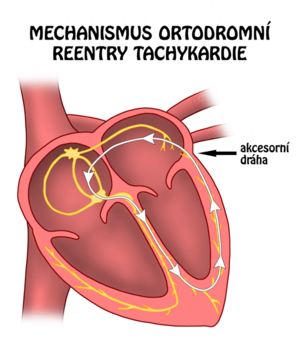Reentry
Reentry, or circular excitation (returning excitation), is the most common arrhythmogenic mechanism, during which the excitation occurs along a functionally or anatomically defined path. Essentially, it is a pathological loop that is faster than the SA node and therefore it replaces it. In order for the reentry circuit to occur, two arms of the circuit with different refractory periods must be present in the myocardium:
- arm with fast conduction and long refractory period;
- arm with slow conduction and a short refractory period.
Reentry mechanism:Propagation of the depolarization wave from point A to point B.
- img. 1 - The fast-track depolarization wave arrives at point B earlier and depolarizes it. The slow path depolarization wave is blocked (does not apply) because it arrives at point B at the moment of its refractory phase.
- img. 2 - At the time of the onset of extrasystole, the fast path is refractory, therefore the excitation spreads only through the slow path, for which the refractory period has already ended. By the time the depolarization wave reaches point B, the fast pathway is still refractory, so the excitation does not return.
- img. 3+4 -However, a situation may arise when, after extrasystole occurs and the depolarization wave reaches point B via the slow path, the fast path is already unblocked (the refractory period has meanwhile ended) and the depolarization wave thus returns to point A. This mechanism is referred to as reentry (circular excitation ) and is the basis of various tachyarrhythmias.
The principle of orthodromic AV reentry tachycardia:the impulse reaches the ventricles via a physiological route (via the AV node), from which, however, it returns to the atrium via an accessory pathway in the septum between the left atrium and the left ventricle (bundle of James), creating a reentry circuit leading to tachycardia.
- Types of reentry
We distinguish between two basic types of circular excitations:
- functional reentry – arises on the basis of functional changes in a certain region of the myocardium;
- anatomical reentry – arises on the basis of a morphological abnormality of a certain part of the myocardium (scars after MI, Kent's bundle, etc.);
- makroreentry;
- mikroreentry.
- Consequences
The reentry mechanism can be the pathophysiological basis of various tachyarrhythmias, e.g.:
- atrial fibrillation or atrial flutter;
- ventricular fibrillation or ventricular flutter;
- supraventricular or ventricular tachycardia.
Links[edit | edit source]
Related articles[edit | edit source]
External links[edit | edit source]
- Mechanisms of Cardiac Arrhythmias - Free ECG book
Source[edit | edit source]
ASCHERMANN, Michael, et al. Kardiologie. 1. edition. Galén, 2004. pp. 1158-1159. ISBN 80-7262-290-0.
{Cite | type = book | surname1 = Nečas | name1 = Emanuel | others = yes | title = Patologická fyziologie orgánových systémů | subtitle = Část I | edition = 1 | location = Praha | publisher = Karolinum | year = 2007 | isbn = 978-80-246-0675-0 (soubor) }} HAMPTON, John R. EKG stručně, jasně, přehledně. 6. edition. Grada, 2005. 149 pp. ISBN 80-247-0960-0.
- HOLAJ, Robert. Kardiologický kroužek. III. interní klinika VFN a 1. LF UK v Praze, 2009.
- VILIKUS, Zdeněk. Interpretace EKG v klidu a při zátěži. Ústav tělovýchovného lékařství 1. LF UK a VFN; 2010.


